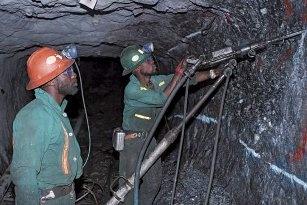The eagerness with which global miners are investing in Africa belies the risks that operating mines on the continent offer the unwary investor
“Beyond the standard risks that miners have to deal with anywhere, like commodity price and currency fluctuation, operating a mine in Africa has a number of risks unique to the continent” says Robin Hancock, Business Development Executive at Alexander Forbes Risk Services.
While nationalisation currently looms large in South Africa, it has been a perennial on the African risk radar for over 40 years. Governments can’t and don’t run mines, instead they appoint private operators to do so. When losses occur in mining these typically run into the hundreds of millions. Experience has shown that governments traditionally don’t insure, however, the “private operators running nationalised mines still need to insure their very substantial risks which remain unchanged regardless of who owns the mine” says Hancock.
Increased risk
So, as in Zimbabwe, if nationalisation takes the form of requiring majority ownership to be held by a local company, or perhaps in South Africa’s case, by a local black-owned company, the major risks remain the same and will have to be insured as before.
“If anything, risks and premiums will actually increase as often nationalised mines lose many of the high level technical and managerial skills that their private competitors are able to retain. This typically leads to increased risk and losses” adds Hancock.
While you can’t buy nationalisation cover in the South African market for a South African owned mine, it may well be provided in the international markets to global miners doing business in South Africa.
Nationalisation aside, a more immediate worry in the South African market is the unfortunate incidence of accidental death on mines. When a death occurs, the Department of Mineral Resources closes the mine, stopping production until the tragedy is fully investigated. Millions can be lost while the mine waits for the department’s go-ahead to resume operations. This delay in production, quite rightfully, cannot be insured.
Legal issues
Equally as worrying for mines in South Africa is a recent ruling upholding a silicosis sufferer’s rights to compensation. Traditionally a settlement under the Compensation for Occupational Injuries and Diseases (COID) Act marked the end of the claims process for employees. However the plaintiff claimed under the Occupational Diseases in Mines & Works Act 78 of 1973. Section 100 (2) of this Act specifically precludes employees with claims in respect of compensatable diseases under that Act from claiming any COID benefits in respect of the same disease. As a COID claim is precluded the door is seemingly now open for the plaintiff, or all employees in general, to institute claims against employers.
Moving to the rest of the continent, a big driver of underwriting costs is each African country’s insistence that risk be underwritten in the local economy. Since in-country African insurers have neither the capacity nor the expertise to underwrite the very large numbers required in mining, most foreign mining operators in Africa get a local insurer to write risk locally and then re-insure the same risk in the South African or international market.
This does, however, make insuring mining operations in Africa more expensive as miners have to pay re-insurance commission, fronting fees, local taxes and VAT.
That said, as African insurance markets become more sophisticated and grow their capacity to carry more risk, it is expected that mining operators in Africa will “increase their dependence on local insurance beyond the vehicle insurance and worker’s compensation currently booked in local markets” predicts Hancock.
Design faults
Loss due to faulty design is also increasingly a risk throughout Africa. In the current market, with projects being delivered to tight timelines, consulting engineers are extremely pressured and generally spread too thin. Faults with processing plants, mine extensions, new equipment etc. are currently causing losses of many millions throughout Africa. These risks should be covered under professional indemnity (PI) policies with a business interruption extension. PI policies are expensive and only underwritten by a few specialist insurers. The advice of a knowledgeable broker is required for placing this cover.
Another problem for many foreign operators starting up in Africa is how to deal with, and cover, medical evacuation of their various personnel.
Typically, a foreign miner starting up in Sierra Leone or the DRC for example will, initially, employ locals as labourers, importing technical and managerial staff from, say, Australia, South Africa or Canada. Evacuation of expatriate employees to home-standard medical facilities is an integral part of most expatriate employment contracts. Since getting a person from the DRC to South Africa usually involves a number of plane and helicopter flights or the transport of an entire medical team, costs can be astronomical.
For example, the cost of bringing an injured person to South African often exceeds a million Rand. For expatriate employees these costs are usually included in Emergency Evacuation policies.
Illness and injury
Problems, however, arise when locals, not covered by generous expatriate packages, fall ill or become injured on the same mine. Should they be sent to a local facility? Is this fair? What are the implications for employee relations? Will local labour-level staff even have passports to remove them to South Africa or the nearest place of adequate care? What would the cost of such a policy be? How best could these costs be covered or offset?
In short, mining operations throughout Africa, including South Africa, are fraught with risk, many of them particular to specific economies, but many others endemic to the continent as a whole. As such, getting the details right requires “broad consultation with risk professionals with a proven track record and customer base operating throughout Africa’s varied and rapidly evolving mining risk market” says Hancock.





















